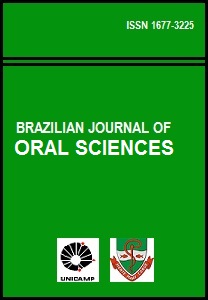Abstract
The objective of this study was to verify the biocompatibility of three different dental adhesives (Single Bond, Clearfil SE Bond and Prime & Bond NT). Thirty-six male rats (Rattus norvegicus, Holtzman) received two subcutaneous implants in the region of their backs. Artificial sponges containing the adhesive material were placed in the cavities and they were polymerized before the surgical site was sutured. As a control, one group was implanted with sponges containing water. Each rat received two implants containing the same adhesive; consequently each group consisted of 9 rats with two implants, resulting in 18 samples per group. After 7, 15 and 30 days, 3 animals of each group were killed and the tissues containing the sponges were analyzed by microscopy. The results showed a great similarity between the control group and the Single Bond implanted tissues, followed by the Clearfil SE Bond and Prime & Bond NT. The Prime & Bond NT adhesive system appeared to show less biocompatibility when compared with the other two tested materials.
References
Nakabayashi N, Pashley DH. Hibridização dos tecidos dentais duros. São Paulo: Quintessence; 2000.
al-Dawood A, Wennberg A. Biocompatibility of dentin bonding agents. Endod Dent Traumatol. 1993; 9: 1-7.
Santos WAG, Barbosa SV. Reação pulpar aos condicionadores ácidos. Rev ABO Nac. 1998; 6: 142-6.
Costa CA, Teixeira HM, do Nascimento AB, Hebling J.
Biocompatibility of an adhesive system and 2- hydroxyethylmethacrylate. ASDC J Dent Child. 1999; 66: 337-42, 294.
Kostoryz EL, Eick JD, Glaros AG, Judy BM, Welshons WV, Burmaster S, Yourtee DM. Biocompatibility of hydroxylated metabolites of BISGMA and BFDGE. J Dent Res. 2003; 82: 367-71.
Geurtsen W, Spahl W, M¨ uller K, Leyhausen G. Aqueous extracts from dentin adhesives contain cytotoxic chemical. J Biomed Mater Res Appl Biomater. 1999; 48: 772–7.
Costa CA, Hebling J, Hanks CT. Current status of pulp capping with dentin adhesive systems: a review.Dent Mater. 2000; 16: 188-97.
Lafeuvre M, Amjaad W, Goldberg M, Stanislawski L. TEGDMA induces mitochondrial damage and oxidative stress in human gingival fibroblasts. Biomaterials. 2005; 26: 5130–7.
Stanislawski L, Lefeuvre M, Bourd K, Soheili-Majd E, Goldberg M, Perianin A. TEGDMA-induced toxicity in human .broblasts is associated with early and drastic glutathione depletion with subsequent production of oxygen reactive specimens. J Biomed Mater Res A. 2003; 66: 476–82.
de Souza Costa CA, do Nascimento AB, Teixeira HM.
Response of human pulps following acid conditioning and application of a bonding agent in deep cavities. Dent Mater.
; 18: 543-51.
Hebling J, Giro EMA, de Souza Costa CA. Human pulp response after an adhesive system application in deep cavities. J Dent.
; 27: 557–64.
Hashimoto M, Ito S, Tay FR, Svizero NR, Sano H, Kaga M, et al. Fluid movement across the resin-dentin interface during and after bonding. J Dent Res. 2004; 83: 843–8.
de Souza Costa CA, Giro EMA, Nascimento ABL, Teixeira HM, Hebling J. Short-term evaluation of the pulpo-dentin complex response to a resin-modi.ed glass-ionomer cement and a bonding agent applied in deep cavities. Dent Mater.
; 19: 739-46.
Estrela C. Metodologia. Científica: ensino e pesquisa em odontologia. São Paulo: Artes Médicas; 2001.
Upman PJ, Wallin RF. A practical guide to ISO 10993-3: carcinogenicity. Med Device Diagn Ind [serial on the Internet].
[cited 2004 Sept 16]. Available from: http:// www.devicelink.com/mddi/archive/99/01/017.html.
Costa CA, Oliveira MF, Giro EM, Hebling J. Biocompatibility of resin-based materials used as pulp-capping agents. Int Endod J. 2003 Dec; 36: 831-9.
Cox CF, Kim KM, Stevenson RG 3rd, Hafez AA. Histological evaluation of a self-priming etchant adhesive system. Compend Contin Educ Dent. 2003; 24(8 Suppl): 17-20; quiz 61.
Gilpatrick RO, Johnson W, Moore D, Turner J. Pulpal response to dentin etched with 10% phosphoric acid. Am J Dent. 1996; 9: 125-9.
Mussel RL, De Sa Silva E, Costa AM, Mandarim-De-Lacerda CA. Mast cells in tissue response to dentistry materials: an adhesive resin, a calcium hydroxide and a glass ionomer cement. J Cell Mol Med. 2003; 7: 171-8.
Consolaro A. Ácidos e sistemas adesivos sobre a polpa dentária: Uma abordagem crítica. Rev Bras Odontol. 1997 54: 198- 203.
Cortes O, Garcia C, Bernabe A. Pulpal evaluation of two adhesive systems in rat teeth. J Clin Pediatr Dent. 2000; 25: 73-7.
Ivanyi I, Balogh AE, Rosivall L, Nyarasdy I. In vivo examination of the Scotchbond Multi-Purpose Dental Adhesive System in rat (vitalmicroscopic study). Oper Dent.
; 25: 418-23.
Akimoto N, Momoi Y, Kohno A, Suzuki S, Otsuki M, Suzuki S, Cox CF. Biocompatibility of Clearfil Liner Bond 2 and Clearfil AP-X system on nonexposed and exposed primate teeth. Quintessence Int. 1998; 29: 177-88.
Koliniotou-Koubia E, Dionysopoulos P, Koulaouzidou EA, Kortsaris AH, Papadogiannis Y. In vitro cytotoxicity of six dentin bonding agents. J Oral Rehabil. 2001; 28: 971-5.
Nagen-Filho H, Monteiro CR, Nagem HD, Lage-Marques JL.Effect of dental adhesives on the exudative phase of the inflammatory process in subcutaneous tissue of rats. Pesqui Odontol Brás. 2003; 17: 109-12.
Vajrabhaya LO, Pasasuk A, Harnirattisai C. Cytotoxicity evaluation of single component dentin bonding agents. Oper Dent. 2003; 28: 440-4.
The Brazilian Journal of Oral Sciences uses the Creative Commons license (CC), thus preserving the integrity of the articles in an open access environment.


